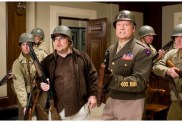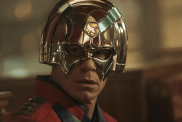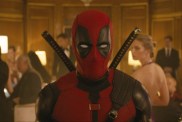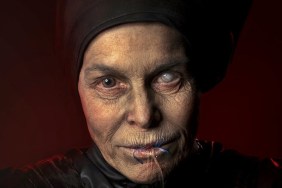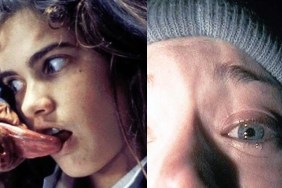
SHOCK builds a case for director/star Anthony Perkins’ haunting PSYCHO III.
There is no God!
So screameth fallen Sister Maureen who kneels before an illuminated statue of the Virgin Mary, fervently pleading for guidance, for a sign that God does in fact exist. Over the next 90 minutes, the narrative that slowly unfolds before both her and us, the audience, will provide an answer, albeit a cold, empty and ultimately tragic one.
Yes, Maureen, there IS a God.
And his name is Norman Bates.
For as the lost ex-nun wanders through the desert to the melancholy strains of Carter Burwells lilting title theme, towards the black, beaten down haunted palace that is the Bates Motel, it is clear that Charles Edward Pogues script for the Anthony Perkins directed sequel PSYCHO III has a metaphorical agenda, one with more than just kinky thrills and second reel shocks on its morbid mind.
Released theatrically in 1986 to generally dismal critical notices (except the late, great Roger Ebert who liked the picture almost as much as I do) PSYCHO III, though it boasts its fair share of graphic skin ripping violence, was at odds with many of its mid 80s slasher flick contemporaries in that it favors atmosphere, allegory and character over a running time-padding body count. The movie is profoundly aware that it hasnt a hope in matching or exceeding the import of Alfred Hitchcocks groundbreaking 1960 black comic nail biter masterpiece and has little interest in following in the footsteps of Richard Franklins Tom Holland-scripted1982 effort Psycho II. It instead elegantly mounts itself as a Tennessee Williams-tinted musing on the desperate lives of a pack of profoundly lost, achingly downtrodden people who, like many of us, are just looking for an exit. And of course, theres plenty of nudity, blood and homicidal transvestitism thrown in, just to balance the scales.
Now, then. The plot

Reeling from a botched suicide attempt that results in the death of her Mother Superior, disgraced Bride of Christ Maureen Coyle (Diana Scarwid, MOMMIE DEAREST) packs a suitcase and hits the road to nowhere. Her aimless travels lead her to the dilapidated but still functioning Bates Motel, the legendary road stop inn run by recently released cross dressing, mother obsessed psychopath Norman Bates (once again essayed by the inimitable Perkins).
When we last saw Bates in PSYCHO II (this film takes place one month after the climax of that picture), he was legally sane and attempting to re-adjust to normal life. Of course, certain people, still bitter over events from the first installment, did their best to drive poor Norman mad anew and succeeded smashingly. Now the twitchy, aging corduroy blazer wearing lunatic lives a quiet life of simmering but stabilized dementia with his newly stuffed, completely dead, still perched in the window mother. That is, until the damaged Maureen strolls into town.
A ringer for Marion Crane, Janet Leighs untimely shower slaughtered victim in the original, (they even have the same monogram) Maureens blonde, wispy presence sends Norman swirling into a neurotic tailspin, the projected voice of his desiccated matriarch urging him endlessly to just kill the whore. He reluctantly obliges, finally donning moms duds and sneaking into cabin one, butcher blade in tow only to uncover the troubled Maureen lying in a tub of her own blood, red stained razor by her side, wrists still pumping fluid. As her self-destructive life force ebbs, she imagines the wigged, frocked Bates to be the Blessed Virgin and, after Norman opts to drive her to the hospital, thus saving her life, the girl becomes fixated by the notion that the serial killer is her savior, her light at the end of long, dark and troubled tunnel. As their ensuing, awkward and childish romance evolves, Normans new employee, a greasy drifter named Duke (a stubbly Jeff Fahey at the top of his scumbag game) and a tireless female tabloid reporter (THE CHANGELINGs Roberta Maxwell) are keeping their eyes on the madman, waiting for him to buckle. And buckle he does, of course

PSYCHO III marks the directorial debut of the eternally typecast Perkins (who, by this point must have signed on as Bates with the contract clause that he would only do it if he could be boss behind the lens) and truly, he does an outstanding job here. Reverently tipping his hat to his master, Perkinss picture is indeed ripe with the same shuddery, off color shock humor that marked Hitchcocks best work (Hitch himself often confessed that Psycho was intended as a ghoulish comedy); witness the scene where amiable yet obtuse Sheriff Hunt (Hugh Gillin, reprising his role from Psycho II) vehemently defends Normans honor while absent mindedly huffing ice from the ice machine, his fat fingers narrowly missing the butchered spoils of a recently dispatched female victim while repulsively (and hilariously) scarfing down the blood dripping cubes (and licking his fingers no less!). But again, Perkins and screenwriter Pogue (he of Cronenbergs THE FLY) are far less concerned with imitation than they are at observing the patterns of hearts without hope. And when PSYCHO III really works, its because the filmmakers are walking besides Bates, dragging him out of the shadows and studying him out in the open, somewhat sympathizing with his deranged plight, even as he drags his blade across the exposed throat of yet another unwitting woman.
See, the tragedy of Norman Bates and make no mistake, Bates IS a tragic figure is that he is, at his core, a good person. Yet so fractured is his fragile psyche from years of protracted childhood abuse that his mind has essentially split (much like the famous Saul Bass title treatment) leaving him at constant war with himself and the grim, torturous reality of his hopeless situation. In PSYCHO III, its clear that Norman is fully aware of his madness, with the notion that the thing he calls mother doesnt necessarily exist outside the parameters of his perception. But, exhausted after years of keeping her blood hungry presence at bay, he has simply resigned himself to accepting her, living with her and thus drowning in his own lethal, sexual psychosis.
Now, down to brass taxes: Is PSYCHO III a good film?
Well, much like Dr. Fred Richmond explains in the epilogue of the original, yes and no. I believe the film works incredibly well as a meditative, meandering mood piece and sneering growl against the folly of blindly following an organized religion. For what is our doomed heroine Maureen if not a human pinball, crushed by the oppression of the church and yet still foolishly seeking some kind of messiah, a reason outside of herself for existing? In fact, I find the off kilter relationship between her and Bates to be the single most interesting element of ANY of the Psycho films, the most real, the most human.
Im also in love with the look of this picture, the dusty, John Ford-esque landscapes captured by cinematographer Bruce Surtees are breathtaking and, coupled with that delicious Carter Burwell score, push the picture squarely into an art house horror territory. But admittedly, what damages the movie and what depressingly prevents it from becoming what it might have been is the cheap, ineffective but obligatory 80s gore and gratuitous nudity. I cant believe Im saying this but the useless boobs and open wounds really hurt the picture, cheapen it, drag it down into the low rent slasher flick ghetto when it clearly cries to be something more evolved.

Theres one sequence in PSYCHO III that, for me, summarizes not only what is truly wonderful about the movie, but is one of the most lyrical scenes in the history of horror movies, period.
After the opening credits, when the camera fades into the motel and the tumbleweeds roll and the dust blows and the wind hisses, the camera pans up, up, up the hill to the Bates house. We see a birdfeeder and the various lovely winged creatures that are drawn to it, like the pretty things that have, in the past, gravitated towards the motel itself.
Suddenly a finch gets woozy, flapping its wings, shaking its head and dropping to the ground, convulsing in death. Then a blackbird follows suit, a sparrow soon after. The shadow of Norman Bates creeps into frame over the feathered, obviously poisoned bodies, and he then gently, tenderly, collects his feathered victims and places them in a brown paper bag.
The next scene sees Norman in his kitchen engaging in his favorite pastime (outside of murder), taxidermy. As he cuts open the belly of one dead bird, he scoops a preserving powder with a spoon into its hollowed out frame, the same spoon that he immediately dips into a jar of Peter Pan peanut butter and uses to spread the very same peanut butter onto a Ritz cracker before eating it.
From the corner of his eye, Bates sees the paper bag move. Both he and we believe it to be a twitch of his polluted imagination. But its not. Its a bird, an inexplicable survivor of the hunt. Delighted, Bates cradles the fragile creature and smiling, opens his back door and sets it free. As the bird flies into the sky, we see a look of such calm, such sweetness across Normans face.
In less than 5 minutes, Perkins deftly defines the character that had dogged him his entire professional life, right up until his death of AIDS in 1992.
Child. Victim. Killer. Saint.
Ladies and Gentlemen, I give you…Norman Bates.
(Note: portions of this essay appeared in Chris Alexander’s Blood Spattered Book, from Midnight Marquee Press)
